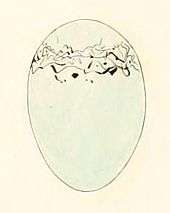Greyish saltator
| Greyish saltator | |
|---|---|
 | |
| In the Pantanal, Brazil | |
| Scientific classification | |
| Kingdom: | Animalia |
| Phylum: | Chordata |
| Class: | Aves |
| Subclass: | Neornithes |
| Infraclass: | Neognathae |
| Superorder: | Neoaves |
| Order: | Passeriformes |
| Suborder: | Passeri |
| Infraorder: | Passerida |
| Superfamily: | Passeroidea |
| Family: | see text |
| Genus: | Saltator (but see text) |
| Species: | S. coerulescens |
| Binomial name | |
| Saltator coerulescens (Vieillot, 1817) | |
The greyish saltator (Saltator coerulescens) is a seed-eating songbird that is widespread in the tropical Americas. Traditionally placed in the cardinal family (Cardinalidae), the saltators actually seem to be closer to the tanagers (Thraupidae).[2] In El Salvador, it is well known as dichosofui after the "elaborate" version of its call, which sounds like a drawn-out ¡dichoso fui!, Spanish for "I was happy!"
Description

On average, the greyish saltator is 20 cm long and weighs 52 g. The plumage depends on age and subspecies, but in general this bird has grey or greyish-olive upperparts, a white stripe over the eye, a narrow white throat, a grey breast and a buff or cinnamon belly.
The common call is a long-drawn upward slur, ch'wheeet or ch'kweeee, sometimes with a more elaborate beginning, as hi'whee chu weeeeh. The song is a warble, usually fairly short, varying from nasal to mellow.[3]
Taxonomy
The genus Saltator is apparently polyphyletic. Whether the present species will remain in Saltator or eventually be moved to another genus remains to be seen; it appears to be rather close to the type species, the buff-throated saltator, and thus seems more likely than not to retain its genus name.[2]
There are 13 subspecies, several of which are considered full species by some authors, mainly on the basis of vocalisations.[4]
Distribution and ecology
This species occurs in open woodland, plains and scrub, from Mexico through Central America into southern South America, south to Peru and the Paraná River region in northern Argentina.[5] The greyish saltator feeds on fruits,[6] buds and slow-moving arthropods. It forages at low and middle levels, sometimes in pairs or small groups and sometimes with mixed-species flocks that may include other saltators.[3]

The two pale blue subelliptic eggs per clutch measure some 23–31.5 mm long by about 17–22 mm wide and weigh about 5 grams each. They look unusual for this genus as they have a circle of blackish-brown hairstreaks and dots around the blunt end.[7] They are laid in a bulky cup nest 2–4 m high in a tree.
References
- ↑ BirdLife International (2012). "Saltator coerulescens". IUCN Red List of Threatened Species. Version 2013.2. International Union for Conservation of Nature. Retrieved 26 November 2013.
- 1 2 See the genus article for details
- 1 2 Howell & Webb (1995)
- ↑ Peterson (1999)
- ↑ BLI (2004), Bencke (2007)
- ↑ E.g. of Trophis racemosa (Moraceae): Forster (2007).
- ↑ Echeverry-Galvis & Córdoba-Córdoba (2006)
Further reading
- Bencke, Glayson Ariel (2007): Avifauna atual do Rio Grande do Sul, Brasil: aspectos biogeográficos e distribucionais ["The Recent avifauna of Rio Grande do Sul: Biogeographical and distributional aspects"]. Talk held on 2007-JUN-22 at Quaternário do RS: integrando conhecimento, Canoas, Rio Grande do Sul, Brazil. PDF abstract
- Echeverry-Galvis, María Ángela & Córdoba-Córdoba, Sergio (2006): Descripción del huevo del saltátor collarejo (Saltator cinctus) y comentarios preliminares sobre huevos del género Saltator. ["Description of the egg of the Masked Saltator (S. cinctus) and preliminary comments on the eggs of the genus Saltator"]. Boletín de la Sociedad Antioqueña de Ornitología 16(1): 76-84. [Spanish with English abstract] PDF fulltext
- ffrench, Richard; O'Neill, John Patton & Eckelberry, Don R. (1991): A guide to the birds of Trinidad and Tobago (2nd edition). Comstock Publishing, Ithaca, N.Y.. ISBN 0-8014-9792-2
- Foster, Mercedes S. (2007): The potential of fruiting trees to enhance converted habitats for migrating birds in southern Mexico. Bird Conservation International 17(1): 45-61. doi:10.1017/S0959270906000554 PDF fulltext
- Hilty, Steven L. (2003): Birds of Venezuela. Christopher Helm, London. ISBN 0-7136-6418-5
- Howell, Steven N. G. & Webb, Sophie (1995): A Guide to the Birds of Mexico and Northern Central America. Oxford University Press, Oxford & New York. ISBN 0-19-854012-4
- Peterson, Alan P. (ed.) (1999): Birds of the World - current valid scientific avian names: Cardinalidae. Version of 2007-AUG-10. Retrieved 2007-SEP-17.
- Stiles, F. Gary & Skutch, Alexander Frank (1989): A guide to the birds of Costa Rica. Comistock, Ithaca. ISBN 0-8014-9600-4
External links
| Wikimedia Commons has media related to Saltator coerulescens. |
- Photograph from the Salvadoran Ministry of the Environment and Natural Resources
- Bird song display list with .wav file of call
- Grayish Saltator videos, photos & sounds on the Internet Bird Collection
- "Grayish Saltator" photo gallery VIREO Photo-High Res--(Close-up)
- "Grayish Saltator" photos from Suriname
